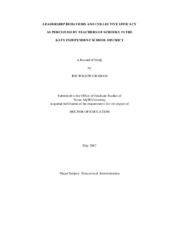| dc.contributor.advisor | Hoyle, John | |
| dc.creator | Graham, Joe Wilson | |
| dc.date.accessioned | 2007-09-17T19:41:22Z | |
| dc.date.available | 2007-09-17T19:41:22Z | |
| dc.date.created | 2003-05 | |
| dc.date.issued | 2007-09-17 | |
| dc.identifier.uri | https://hdl.handle.net/1969.1/6004 | |
| dc.description.abstract | The primary purposes of this study were to discover any connections between
leadership effectiveness and collective efficacy from campuses in the Katy Independent
School District. It also was designed to discover other possible connections between
teacher demographic variables and collective efficacy. The research study for leadership
was based on the leadership work of Kouzes and Posner and the survey they created, the
Leadership Practices Inventory (LPI). The collective efficacy piece was based on the
work of Roger Goddard and his work on the collective efficacy survey for school
personnel.
Leadership effectiveness had a low positive correlation on collective efficacy.
All five practices also had a low positive correlation on collective efficacy. These
practices are: Model the Way, Inspire a Shared Vision, Challenge the Process,
Encourage Others to Act, and Encourage the Heart. The Challenge the Process practice
had the highest correlation on collective efficacy.
Each of the practices had breaks at the 30th and 70th percentile groups based on
Kouzes and Posner’s norming group of approximately 18,000 participants. Schools
scoring in the below the 30th percentile group in the Model the Way practice werestatistically significantly different than schools scoring in the middle or upper ranges.
Schools scoring in the below the 30th percentile group in the Encourage Others to Act
practice were statistically significantly different than those scoring in the middle or
upper groups as well. There were no other practices showing significant differences in
their respective groups.
Most length of employment variables showed a low correlation on leadership
effectiveness and collective efficacy. Length of employment in Katy ISD had a
moderate negative correlation on leadership effectiveness.
The researchers categorize schools as schools with high or low collective
efficacy based on the teacher comments. High collective efficacy schools commented
that they worked as teams and had administrative support. Lower collective efficacy
schools mentioned administrative constraints, home life issues, lower administrative
support, and lower discipline.
The schools were categorized as positive leadership mentioned administrative
support, encouragement, and principals who listened. In more negative leadership
schools, teachers commented about communication problems and minimal rewards. | en |
| dc.format.extent | 1219836 bytes | en |
| dc.format.medium | electronic | en |
| dc.format.mimetype | application/pdf | |
| dc.language.iso | en_US | |
| dc.publisher | Texas A&M University | |
| dc.subject | leadership | en |
| dc.subject | effectiveness | en |
| dc.subject | collective efficacy | en |
| dc.title | Leadership behaviors and collective efficacy as perceived by teachers of schools in the Katy Independent School District | en |
| dc.type | Book | en |
| dc.type | Thesis | en |
| thesis.degree.department | Educational Administration and Human Resource Development | en |
| thesis.degree.discipline | Educational Administration | en |
| thesis.degree.grantor | Texas A&M University | en |
| thesis.degree.name | Doctor of Education | en |
| thesis.degree.level | Doctoral | en |
| dc.contributor.committeeMember | Collier, Virginia | |
| dc.contributor.committeeMember | Hall, Robert | |
| dc.contributor.committeeMember | Skrla, Linda | |
| dc.type.genre | Electronic Record of Study | en |
| dc.type.material | text | en |
| dc.format.digitalOrigin | born digital | en |


